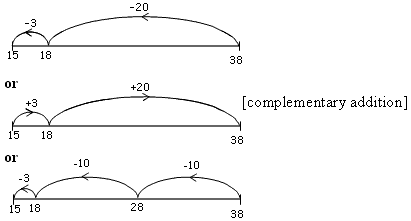Number line subtraction
This task is about showing how to solve equations on a number line.
Read through the example in the box before you start.
|
Example: Pere had to solve 46 –  = 24 using a number line. = 24 using a number line.He knew that 46 – 20 = 26, and that 26 – 2 = 24, so 46 – 22 = 24 He showed this as jumps on the number line and then wrote the answer in the box:  |
For each question below:
- Show how to solve the equations on the number line.
- Write the answer in the empty box.
|
a)
|
Use the number line below to show how to solve: 38 –
 = 15 = 15 |
|
b)
|
Use the number line below to show how to solve: 53 –
 = 19 = 19 |
|
c)
|
Use the number line below to show how to solve: 82 –
 = 35 = 35 |





